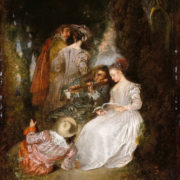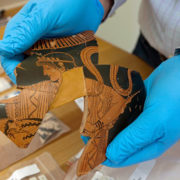On the “Pride and Prejudice” of Conservators: Lecture by Dr. Salvador Muñoz-Viñas a the IFA.
Ruth Osborne

Dr. Muñoz-Viñas at the IFA.
Last week, the IFA (NYU) hosted a lecture by visiting professor and conservator Dr. Salvador Muñoz-Viñas of the Universitat Politència de València in Spain. As the author of the insightful Contemporary Theory of Conservation (2005), Dr. Muñoz-Viñas argued for the need for a more open dialogue about conservation treatments and their difficulties. Rather than presenting conservation as a dogmatic science, he took a rather humble and honest opinion that we at ArtWatch find refreshing and, indeed, necessary for the future of the field.
Muñoz-Viñas began by asserting his presentation would be thought-provoking. Choosing from a wide array of opinions from professionals in the field over the past two centuries, he asked the audience to consider the reasoning behind conservation treatment. The speaker did not shy away from such harsh criticisms for and against those removers of varnish, including Ernst Gombrich’s label of “radical stripper” versus John Constable’s “grime-loving connoisseur.” He admitted to the risky nature of removing varnish, but did not display any kind of defensive attitude towards those who questioned the work of the conservator
The larger goals of conservation came into question: what is the logic behind such a risky endeavor? Is it to attain a closer, more “authentic” vision of the artist’s original intent? Actually, M-V argued that the classical narrative of artist’s intent is vaporous, highly hypothetical, and doubly subjective, as our minds attempt to delve into that of the artist. Pointing out the conflicting statements on the purpose of conservation in the classic essay by Neil Maclaren and Anthony Werner (1950)[1], he gave a warning to the audience (which consisted of both professional conservators and students in conservation): the logic of the field has the potential to be misleading. It can almost act as a mythology. Do we even care about the artist’s original intent when, for example, we display an ancient Egyptian sarcophagi on a white pedestal in the middle of a gallery? Certainly not. Intention behind conservation is more complicated than that. This near-mythology dangerously supposes that the individual utilizing it – the conservator – is a robot carrying out a basic procedure. He or she either obeys a command or does not.
However, as M-V went on to explain, there are elements of “pride” and “prejudice” in the conservator that will inevitably impact the work they are treating. Quoting connoisseur Sir George Beaumont’s famous line “A good picture, like a good fiddle, should be brown,” he insisted that there is aesthetic prejudice inherent in anyone’s mind. For a conservator, this will alter the way one thinks a painting should be treated, and to which aesthetic preference to which it will yield when its treatment is complete. Psychologists’ study of modern aesthetic preferences, M-V pointed out, is just now beginning. This should have the potential to help us understand what visual prejudices are behind the work of conservators that then end up on a treated canvas.
Pride, too, is at work in the hand of a conservator, for why wouldn’t one want to be noticed for their painstaking work behind-the-scenes? While “greed” and “avarice” have been presented as the major threats to artworks at the hands of the conservator, M-V countered that these are easier to deal with than the pride that inevitably impacts the conservator’s treatment. This pride, he believes, is part of the necessary process of going about planning to treat a painting. A conservator must have a pre-conceived notion of how a painting should look look (or, at least, about how a painting should not look) that is an essential part of his or her approach to the point of its “cleaning.”
This insistence that we acknowledge a conservator’s humanity, that he or she is not an objective “scientific” robot participant, is essential in opening the dialogue about how works of art are cared for. If anything, working towards a better understanding of the conservator’s preconceived point of view, their own aesthetic curiosity, sense of beauty, etc. that impact their hand and eye in treatment, is a step forward in the discussion of artistic stewardship.
By Ruth Osborne
[1] Neil Maclaren and Anthony Werner, “Some Factual Observations about Varnishes and Glazes,” The Burlington Magazine. 92 (1950), 189-92.











Leave a Reply
Want to join the discussion?Feel free to contribute!